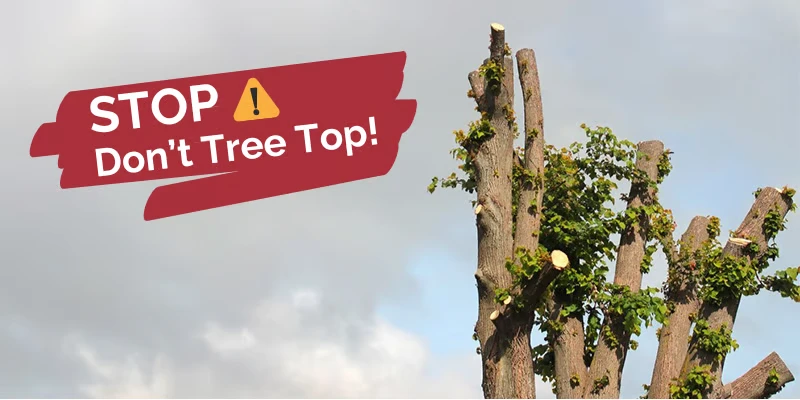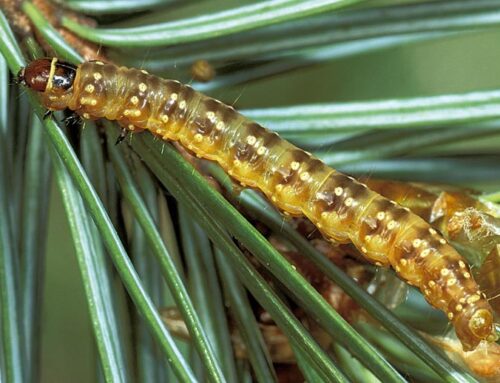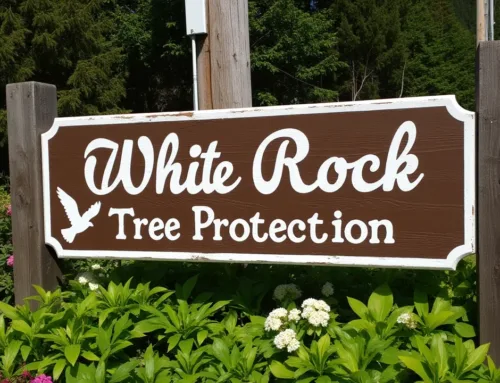The Dangers of Tree Topping: Why This Practice Threatens Your Trees and Property

If your tree feels too tall, too wide, or just out of control, topping might seem like a quick fix. But here in British Columbia, this harmful method can do more damage than good. At Ruby Tree Care, we’ve seen how topping leads to weak regrowth, safety issues, and expensive removals. Let’s examine why it’s a risk—and what to do instead.
What Is Tree Topping?
Topping means cutting large branches back to stubs or chopping off the top of a tree to reduce its size. The tree panics and sends out lots of weak shoots, which grow fast but aren’t strong. This practice involves removing the main leader or cutting back large branches to lateral branches that are too small to assume the terminal role.
We also remind clients that tree topping is discouraged and often illegal in many BC municipalities, due to the long-term risks it creates. Many local bylaws specifically prohibit this practice on both private and public property, with violations carrying substantial fines. Our guides on Surrey tree protection bylaws, White Rock tree protection bylaw, understanding tree bylaws in Abbotsford, and Township of Langley tree bylaws provide detailed information about local regulations.

Why Topping Doesn’t Work
Weak Growth: The new shoots break easily, especially in BC’s rainy, windy seasons. These rapidly growing water sprouts lack the cellular structure of normal branch development. They attach poorly to the parent branch and become increasingly hazardous as they mature. During storms common to our coastal climate, these weakly attached branches frequently fail, creating safety hazards for people and property below.
Tree Stress: Losing too many branches at once affects photosynthesis and weakens the tree. Trees depend on their leaves to produce food through photosynthesis, and removing large portions of the canopy forces the tree to use stored energy reserves. This depletes the tree’s resources needed for root development, disease resistance, and normal growth functions. The stress response often makes trees more susceptible to insect infestations and fungal diseases, including the top 3 tree pests this spring in British Columbia.
Disease Risk: Open cuts never heal properly and can lead to rot or infection. Unlike smaller pruning cuts that can compartmentalize and heal, large topping cuts create wounds too large for the tree to seal effectively. These open wounds become entry points for decay fungi, bacteria, and insects. The resulting rot spreads internally, compromising the tree’s structural integrity over time.
Higher Costs: You’ll need more frequent pruning—or face full tree removal down the line. Topped trees require ongoing maintenance as weak sprouts must be regularly removed or reduced. The cyclical nature of this maintenance creates ongoing expenses that often exceed the cost of proper pruning techniques. Many topped trees eventually require complete removal due to structural failure or extensive decay. Learn more about the art and science of tree removal when trees can no longer be saved.
The Hidden Consequences of Topping
Beyond the immediate visible damage, topping creates several long-term problems that property owners often don’t anticipate. The practice fundamentally alters the tree’s natural architecture, disrupting the balanced weight distribution that healthy trees develop over decades.
Topped trees lose their natural beauty and property value. Real estate professionals consistently report that well-maintained mature trees add significant value to properties, while topped or damaged trees detract from curb appeal and market value. The unnatural appearance of topped trees with their stubby branches and dense clusters of weak growth rarely recovers to an attractive form.
Insurance implications also arise from topping. Many insurance companies view topped trees as increased liability risks due to their higher failure rates. Property owners may face challenges with claims if damage occurs from a tree that has been previously topped, particularly if the topping was performed contrary to accepted arboricultural standards.
The Healthier Option: Crown Reduction & Crown Cleaning
Crown reduction is a smarter, safer way to manage tree size. Our ISA-certified arborists throughout the Lower Mainland carefully shorten select branches to keep the tree balanced and strong. This technique involves cutting branches back to lateral branches that are large enough to assume the terminal role, maintaining the tree’s natural form while reducing overall size.
For some trees, crown cleaning may be the better option—removing only dead, diseased, crossing, or hazardous branches while preserving the natural structure. This selective approach addresses specific problems without compromising the tree’s overall health or appearance. Discover more about the hidden benefits of proper tree pruning and why expert care makes such a difference.
At Ruby Tree Care, we follow ANSI A300 pruning standards and:
- Never remove more than 25–30% of a tree’s foliage in a single season
- Thin dense canopies to reduce wind resistance while maintaining structural integrity
- Prioritize structural balance and long-term tree health over quick fixes
- Reduce weight on heavy limbs to prevent failure while preserving the tree’s natural form
Species-Specific Considerations
Different tree species respond differently to pruning, making professional assessment valuable. Douglas firs, common throughout BC, have limited ability to produce new growth from older wood, making topping particularly devastating for these species. Deciduous trees like maples and oaks can produce new growth more readily but still suffer significant stress and structural problems from topping.
Fruit trees present special considerations, as improper pruning can eliminate flower and fruit production for several years. Our guide on pruning pear trees in the Lower Mainland provides specific techniques for maintaining both tree health and productivity. Professional arborists understand the timing and techniques needed for different species and their unique requirements.
When Should You Prune?
Every tree is unique. Professional tree pruning services may be needed when:
- You notice dead, damaged, or diseased limbs that pose safety risks
- Trees are too close to buildings, driveways, or power lines, creating hazards
- Limbs are overhanging high-traffic areas where people regularly walk or park
- You want to improve air flow, light access, or tree shape for aesthetic reasons
- Storm damage has created hanging or broken branches
- Trees are interfering with views, solar panels, or other property features
Our certified arborists will assess the best time and technique for each tree, considering factors like species, age, health, and seasonal timing. Proper timing can significantly impact the tree’s recovery and long-term health. For urgent situations, we also provide emergency tree removal services throughout the region.

Protecting Your Trees Year-Round
Beyond proper pruning techniques, protecting your trees involves understanding seasonal care. Tree wrap protection can help young or vulnerable trees survive harsh weather conditions while they establish strong root systems and natural defenses.
Making the Right Choice
Rather than resorting to topping, property owners have several responsible alternatives. Professional crown reduction maintains tree health while addressing size concerns. Regular maintenance pruning prevents problems before they become severe. Sometimes, if a tree has grown too large for its location, complete removal and replacement with a more appropriate species may be the best long-term solution.
Working with certified arborists protects both your investment and your safety. Professional tree care services may cost more initially than topping, but save money over time by maintaining tree health, reducing maintenance needs, and preserving property values. The expertise of trained professionals makes the difference between a quick fix that creates problems and a lasting solution that benefits your landscape for years to come.
When trees do require removal due to safety concerns or irreversible damage from improper care, professional tree removal services in the Lower Mainland follow proper procedures to protect surrounding vegetation and property. After removal, stump grinding services complete the process, allowing you to replant or repurpose the space effectively.
The choice between topping and proper tree care represents a decision between short-term convenience and long-term tree health. By choosing professional arboricultural services and following proper pruning standards, you protect your trees, your property, and your investment while maintaining the natural beauty that makes our BC landscapes so special.


